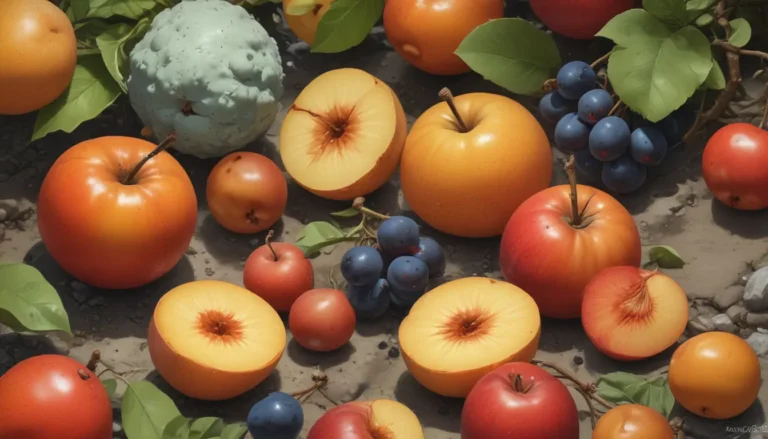Comprehensive Guide to Identifying, Treating, and Preventing Common Apple Diseases

Are you a proud apple tree owner who loves the rewarding experience of enjoying fresh, homegrown apples? If so, you must be aware of the various diseases that can affect apple trees in your garden. While apple trees in the wild are often prone to infections, even homegrown trees are not exempt from diseases caused by fungi and bacteria.
To ensure your apple trees stay healthy and produce delicious fruit, it’s essential to understand the common diseases that can plague them and take appropriate action when needed. This comprehensive guide will help you identify, treat, and prevent the most common apple diseases to keep your trees thriving.
Common Apple Diseases
- Bacterial Infections
- Crown Gall
-
Fire Blight
-
Fungal and Water Mold Infections
- Anthracnose Canker and Bull’s-Eye Rot
- Apple Scab
- Armillaria Root Rot
- Frogeye Leaf Spot and Black Rot
- Phytophthora Crown Rot, Collar Rot, and Root Rot
- Powdery Mildew
- Rust
- Sooty Blotch and Flyspeck
- Southern Blight
-
White Rot (aka Bot Rot)
-
Viral Infections
-
Flat Apple Disease
-
Physiological Disorders
- Bitter Pit
- Chlorosis
- Cork Spot
- Soggy Breakdown
- Sunscald
Bacterial Infections
Bacterial infections are a serious threat to apple trees, with two key diseases worth noting: Crown Gall and Fire Blight.
Crown Gall
Crown gall affects a wide variety of plants and is caused by Rhizobium rhizogenes bacteria. Unfortunately, crown gall is usually fatal for apple trees. Recognizable by the characteristic galls it produces, it’s essential to act swiftly at the first sign of an infection.
Fire Blight
Fire blight, caused by Erwinia amylovora bacteria, leads to tree tips resembling those damaged by fire. This highly contagious disease spreads rapidly, particularly in rainy and humid conditions. To control fire blight, consider pruning and using copper sprays judiciously.
Fungal and Water Mold Infections
Apple trees are susceptible to various fungal pathogens and water molds, complicating disease control efforts. Understanding these diseases can help you manage infections effectively.
Anthracnose Canker and Bull’s-Eye Rot
Anthracnose canker, primarily affecting apple trees in the Pacific Northwest, results from Neofabraea fungi. Canker formation can lead to bull’s-eye fruit rot. Pruning affected parts, applying fungicides, and maintaining good orchard hygiene are key practices for controlling this disease.
Apple Scab
Venturia inaequalis causes apple scab, characterized by lesion formation on leaves and fruit. Planting resistant varieties like ‘Enterprise’ and ‘Pristine’ is an effective prevention method, as apple scab can lead to foliage loss and fruit susceptibility to other diseases.
Armillaria Root Rot
Armillaria mellea, a fatal pathogen for several tree species, causes root rot in apple trees. Prevention involves maintaining well-draining soil conditions and promptly removing infected trees. Armillaria-infected trees exhibit reduced growth and early leaf discoloration.
Frogeye Leaf Spot and Black Rot
Physalospora obtusa fungi trigger frogeye leaf spot, progressing to black rot if left untreated. You can manage these diseases by pruning infected parts, applying sulfur or fungicides, and ensuring adequate airflow in the orchard.
Phytophthora Crown Rot, Collar Rot, and Root Rot
Various Phytophthora species can cause severe diseases in apple trees. Symptoms include reduced vigor and root, trunk, or crown infections. Prevention entails practicing good water management, avoiding overwatering, and choosing well-draining planting sites.
Powdery Mildew
Podosphaera leucotricha causes powdery mildew in apples, leading to stunted growth and foliage wilting. Cultural practices like planting in sunlight and proper spacing aid in disease prevention. Pruning affected shoots and applying sulfur or fungicides can manage powdery mildew.
Rust
Cedar apple rust, attributed to Gymnosporangium juniperi-virginianae fungi, induces orange spots on apple leaves and distorted fruit. This disease, which requires juniper hosts for its life cycle, necessitates the removal of alternate hosts and periodic fungicide spraying for control.
Sooty Blotch and Flyspeck
Fungi causing sooty blotch and flyspeck form blemishes on apple fruit surfaces, impacting marketability. Disease management focuses on ensuring proper air circulation in the orchard and implementing timely harvesting and storage practices.
Southern Blight
Sclerotium rolfsii fungicides target the bases and lower trunks of infected apple trees. While fatal to young trees, older trees develop resistance over time. Effective prevention strategies include planting in low-southern blight areas and removing organic matter around tree bases.
White Rot (aka Bot Rot)
Botryosphaeria dothidea fungi trigger white rot, a disease manifested by cankers on apple trees. Prompt detection and disease management, including promoting tree health and removing infected tissue, are vital for preventing fruit rot and tree deterioration.
Viral Infections
Preventing viral infections in apple trees is challenging due to the lack of available cures. Emphasize using uninfected rootstocks and scion buds, controlling nematode vectors, and selecting virus-resistant cultivars to safeguard trees from viral diseases like CRLV (flat apple disease).
Flat Apple Disease
CRLV-caused flat apple disease, predominantly in the western US, leads to flattened fruit and leaf curling. Control efforts focus on limiting nematode movement, avoiding infected plant sources, and timely tree removal to contain the disease.
Physiological Disorders
While many apple disorders mimic diseases, they result from physiological anomalies rather than active pathogens. Understanding these conditions’ symptoms and causes can help you implement effective management strategies.
Bitter Pit
Characterized by water-soaked lesions on fruit that develop into sunken spots, bitter pit stems from elevated calcium levels in leaves. Prevention includes managing calcium distribution in trees and maintaining climatic conditions conducive to fruit development.
Chlorosis
Iron or manganese deficiencies induce chlorosis, manifesting as leaf yellowing with green veins. Managing deficiencies through soil amendments or foliar sprays based on soil tests can alleviate symptoms and promote tree health.
Cork Spot
Cork spot causes corky or soft spots on apples due to low soil pH hindering calcium uptake. Rectify calcium deficiencies by adjusting soil pH and employing calcium chloride sprays to mitigate the condition effectively.
Soggy Breakdown
Chilling injury like soggy breakdown is exacerbated by cold fruit storage, leading to unattractive brown rings in apples. Storing fruit above 36ºF can mitigate chilling-induced damage and maintain fruit quality.
Sunscald
Sunburned fruit, a result of sunscald, displays yellow or flushed areas susceptible to subsequent fruit darkening. Proper canopy management and avoiding excessive sunlight exposure can minimize sunscald occurrences.
Preventing Apple Tree Diseases
Preventive measures play a crucial role in maintaining apple tree health and minimizing disease risks. By adopting best practices, you can safeguard your trees from common infections and physiological anomalies.
Practice Good Hygiene in the Fall
Eliminating fallen leaves and fruit from the ground in the fall reduces overwintering pathogens, preventing disease resurgence in the following spring. Dispose of debris adequately to avoid disease recontamination.
Sterilize Your Pruning Shears Between Cuts
Regularly sterilizing pruning tools with alcohol or bleach solutions between cuts reduces disease transmission between tree parts. Prioritize tool disinfection, especially when pruning fire blight-infected limbs, to contain infections effectively.
Practice Good Water Management When Planting
Ensuring trees receive adequate drainage and suitable planting sites free of waterlogging significantly reduces disease risks. Proper water management practices like avoiding water accumulation around crown roots minimize apple trees’ susceptibility to severe diseases like Phytophthora root rot.
Conclusion
Apples are delightful fruits that bring joy to many gardeners, but managing diseases and physiological disorders can be challenging. By identifying common apple tree diseases, understanding their causes, and implementing preventive strategies, you can nurture healthy apple trees and enjoy bountiful harvests year after year.
To safeguard your apple trees effectively, prioritize good orchard hygiene, proper pruning techniques, and appropriate water management practices. By adopting these recommendations, you can maintain thriving apple trees and mitigate disease risks effectively.
Have you encountered and successfully managed apple tree diseases in your garden? Share your experiences and insights in the comments below to help fellow apple tree enthusiasts navigate disease challenges.
For comprehensive advice on growing premium apples at home, explore our in-depth guides on apple tree cultivation, harvest timing, and fruit storage best practices.
In conclusion, maintaining healthy apple trees requires a proactive approach to disease prevention and management. By following proper care practices and adopting preventive measures, you can ensure your apple trees thrive and produce delicious fruits year after year. Let your love for homegrown apples shine by nurturing disease-free trees that yield an abundant harvest.





